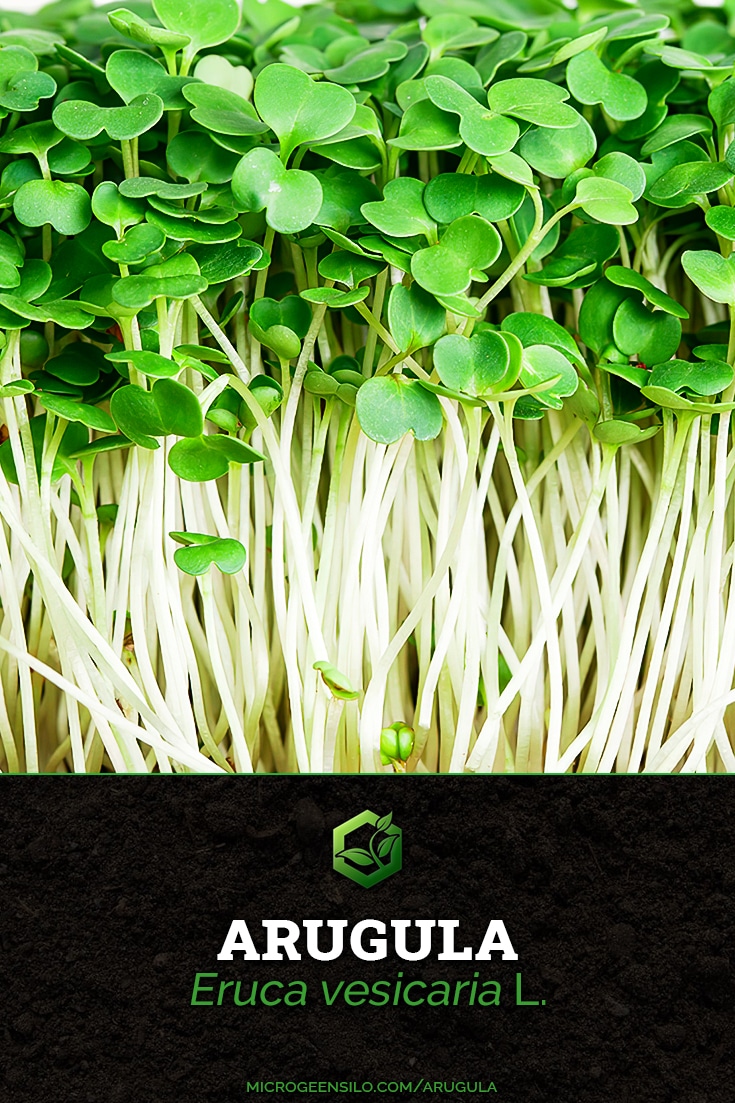Arugula
Graden Rocket
Eruca vesicaria L.
Arugula microgreens are small but mighty, with a peppery taste perfect for salads and sandwiches. Their vibrant colors make any dish pop!
Quick Grow Info:
-
Scientific Name: Eruca vesicaria L.
-
Flavor: Spicey, slightly tart, peppery flavor
-
Seed Rate: 10g-15g per 10″ x 20″ tray
-
Seeds Per in2: 0.05g-0.075g
-
Pre-Soak: No
-
Weight Duration: 2-3 Days
-
Germination Time: 1-2 Days
-
Blackout Time: 1-2 Days
-
Seed To Harvest: 8-12 Days
-
Growing Difficulty: Easy
Did You Know
Fun Fact

In ancient Rome and Egypt, arugula was believed to be an aphrodisiac, spicing up both dishes and desires!
Plant Details &
Grow Guide
How To Grow Arugula Microgreens
Are you craving some Mediterranean peppery flair? Look no further than Arugula microgreens! These tiny powerhouses add a spicy kick to your meals and take your culinary skills to the next level. In just 4-6 days, you’ll have a lush garden of zesty microgreens to enjoy.
Imagine adding vibrant green bursts of nutrition to your meals. Not only will they look great, but they’ll also supercharge your health! Are you ready to grow these little firecrackers? Let’s dive in and discover the fun of growing your own Arugula microgreens. Let’s get our hands dirty!
Step 1 Preparing Your Arugula Seeds
First, you need to measure your seeds using a scale. The best seeding rate for a 10″ × 20″ tray is 10-15 grams. If you plan to grow them in a 10″ × 10″ tray then simply divide the total amount by two, in this case, 5-8 grams.
If you’re a rebel like me you can just eyeball it without weighing, just make sure that your seeds are approx ⅛-¼” (3-6mm) apart.
Once you’ve measured out your seeds you do not need to wash and pre-soak them. This is because arugula seeds are very small, and wetting them will make it a nightmare to spread them evenly on your growing medium.
Step 2 Sowing Your Seeds
Fill your tray with your preferred medium, it can be soil, potting mix, coco coir, etc, leaving 1-2cm of empty space from the tray edge to the soil level.
Leaving a small space between the tray edge and grow medium helps when it comes to harvesting, minimizing the chance of digging into the medium with your knife.
Make sure you level your medium with your hands so it’s not clumpy, you don’t want your seeds grouping together when you sow them.
Start by lightly spraying your growing medium with a spray bottle until it becomes slightly damp, but not overly saturated.
Next, carefully distribute the seeds evenly across the surface of the medium. Take your time to ensure that they are spread out in a uniform manner. Finally, give the seeds a gentle misting with water so that they are all covered with a fine layer of moisture.
Step 3 Germination & Weight Period
Take an empty tray without any holes and put it on top of the seeds you have planted. I usually use a 15lb (6.80kg) paving block for trays that are 10″ x 20″ or a 7lb (3.17 kg) brick for trays that are 10″ x 10″.
This assists the seed’s radicle in penetrating the soil when it starts to grow. Without any weight, the radicles find it more challenging to dig into the growing medium and establish firm roots.
Keep in mind that the seeds will germinate while they’re covered and weighed down. A lot of people confuse the germination and weight period to be independent of one another and that you add them together, this is incorrect.
The germination time is there to give you an idea by what time the seeds will germinate, but you don’t add the germination time and blackout period together.
While your seeds are germinating and are weighed down you will need to keep your medium moist. You can do this by lightly misting your seeds every 12 hours, once in the morning and once at night.
Step 4 Blackout Time
After weighing down the seeds for about 2 to 3 days, they should have sprouted and now you can carefully lift the weighted tray. It’s time to remove the weight and begin the blackout phase.
Take your empty tray and flip it over to create a dome that blocks out light. Place it back over your seeds.
By keeping them in darkness for another 1 to 2 days, the newly sprouted seedlings will naturally stretch and reach out for light, helping them grow taller.
Now you can start watering your arugula microgreens from the bottom. Simply add water to the drainage tray underneath. Personally, I recommend adding 1 cup of water twice a day. Once in the morning and once in the evening (every 12 hours).
Once the blackout period of 1 to 2 days is over, you can remove the top tray or blackout dome and expose your microgreens to light. I’ve found that providing them with 17 hours of light followed by a 7 hour break works well for me.
Continue growing your arugula microgreens for additional 3 to 7 days, remembering to water them daily with approximately 2 cups of water per day. Once every 12 hours.
Step 5 Harvest
Harvesting your arugula microgreens is straightforward that only requires a sharp tool. Personally, I absolutely love using the Green Mercer Produce Knife—I highly recommend it! But if you prefer scissors, that’s also completely fine; just make sure they’re sharp!
Now, here’s an important tip to keep your harvest pristine; make sure to keep your chosen tool (whether it’s a knife or scissors) away from the soil! It’s imperative in avoiding any accidental contact between the blade and the soil, you don’t want any unwanted dirt from sneaking into your microgreen harvest and contaminating it.
By following this important pointer, you’ll ensure that your harvested microgreens are of top notch quality and purity.
Plant Details & Taxonomy
Few plants can blend culinary zest with historical significance as elegantly as Eruca vesicaria L.
It’s an annual plant with a life cycle of 1 year. The seed weight of Eruca vesicaria typically ranges from 400-800 seeds per gram.
The vibrant green leaves make Eruca vesicaria, commonly known as arugula or rocket, a top pick when grown as a microgreen.
Chefs love their peppery flavor and tender texture making them a favorite in gourmet dishes, salads, and as garnishes.
It thrives best in mild to warm climates and tends to bolt quickly in extreme heat.
| Rank | Scientific Name |
| Kingdom | Plantae – Plants |
| Subkingdom | Tracheobionta – Vascular plants |
| Superdivision | Spermatophyta – Seed plants |
| Division | Magnoliophyta – Flowering plants |
| Class | Magnoliopsida – Dicotyledons |
| Subclass | Dilleniidae |
| Order | Capparales |
| Family | Brassicaceae – Mustard family |
| Genus | Eruca Mill. – Rocketsalad |
| Species | Eruca vesicaria (L.) Cav. – Rocketsalad |
| Subspecies | Eruca vesicaria (L.) Cav. ssp. sativa (Mill.) Thell. – Rocketsalad |
| Common Names | Rocket, Garden rocket, Colewort, Roquette, Ruchetta, Rucola, Rucoli, and Rugula. |
Microgreen Pests & Diseases
The following are the most common pests and diseases that can affect your microgreens.
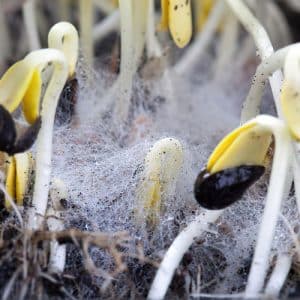
White Mold – Sclerotinia sclerotiorum
Sclerotinia sclerotiorum is a necrotrophic fungal disease that causes what’s known as white mold, it can infect over 400 plant species worldwide. It’s also called cottony soft rot, stem rot, watery soft rot, crown rot, and seedling blight.
S. sclerotiorum key properties are its ability to create sclerotia which are its black resting structures, and mycelium which are the white fuzzy spiderweb-like growths you see on stems and growing medium.
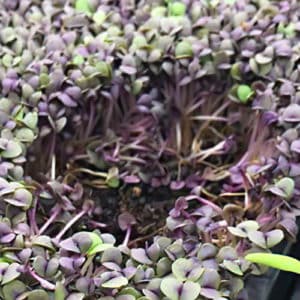
Damping Off
Damping-off is an umbrella term that covers fungi and fungi-like organisms in several genera including Rhizoctonia, Botrytis, Phytophthora, and Fusarium, with the soil fungus Pythium being the often culprit.
Damping-off is a soil-borne fungal disease that affects seeds and seedlings typically by rotting of the stems and roots at and below the soil surface.
When a seed germinates the seedling will emerge fine but within 24 hours to a few days will become mushy and water-soaked, collapse at the base of the stem and die.
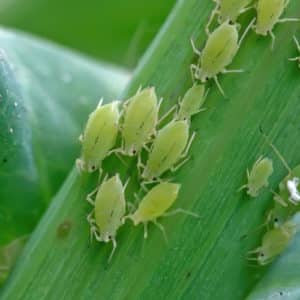
Aphids – Aphidoidea
Aphids suck! Quite literally. They’re soft-bodied insects that use their piercing-sucking mouths to feed on plants and there are over 4,000 aphid species in the world.
Other common names are greenflies, blackflies, and plant lice. They come in varying colors such as light green, black, white, brown, gray, or yellow.
When aphids feed on plants they secrete a sticky fluid which is called honeydew (no, don’t eat it). This goo they leave behind drips onto plants and can attract other pests such as ants. If the honeydew is left on leaves it can promote black sooty mold.
Arugula Nutrition Facts
Arugula microgreens are a low-calorie food with a balanced macronutrient profile, with 3.65g of carbohydrates and 2.58g of protein per serving.
They are cholesterol-free and rich in dietary fiber, essential vitamins, and minerals.
Incorporating arugula microgreens into your meals can add both flavor and nutritional value.
| Principle | Nutrient Value | Unit | RDA |
| Energy | 25 | Kcal | 1% |
| Carbohydrates | 3.65 | g | 3% |
| Protein | 2.58 | g | 5% |
| Total Fat | 0.66 | g | 1% |
| Cholesterol | 0 | mg | 0% |
| Dietary Fiber | 1.6 | g | 4% |
| Vitamins | |||
| Folate | 15.3 | µg | 3% |
| Selenium, Se | 97 | µg | 24% |
| Vitamin A | 0.3 | µg | 1% |
| Vitamin B1 (Thiamin) | 119 | mg | 159% |
| Vitamin B2 (Riboflavin) | 0.044 | mg | 4% |
| Vitamin B3 (Niacin) | 0.086 | mg | 7% |
| Vitamin B5 (Pantothenic acid) | 0.305 | mg | 2% |
| Vitamin B-6 (Pyridoxin) | 0.073 | mg | 6% |
| Vitamin C | 15 | mg | 17% |
| Vitamin E | 0.43 | mg | 3% |
| Vitamin K | 109 | µg | 91% |
| Electrolytes | |||
| Sodium, Na | 27 | mg | 1.80% |
| Potassium, K | 369 | mg | 7.85% |
| Minerals | |||
| Calcium, Ca | 160 | mg | 16.00% |
| Copper, Cu | 0.076 | mg | 8.44% |
| Iron, Fe | 1.46 | mg | 18.25% |
| Magnesium, Mg | 47 | mg | 11.46% |
| Manganese, Mn | 0.321 | mg | 13.96% |
| Phosphorus, P | 52 | mg | 7.43% |
| Potassium, K | 369 | mg | 7.85% |
| Zinc, Zn | 0.47 | 4.27% | |
| Phytonutrients | |||
| β-Carotene, beta | 1420 | µg | 35.50% |
| α-Carotene, alpha | 0 | µg | 0.00% |
| Lutein + zeaxanthin | 3560 | µg | 59.33% |
Recommended Products
Explore my top curated picks for products needed to grow microgreens. Rest assured that all the featured items and products have been meticulously put to the test by me or have received glowing recommendations from my esteemed readers.
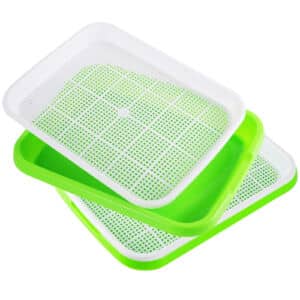
Microgreen Grow Trays
For my personal home use, these microgreen trays are my go to. Measuring around 12.2 x 9.06 x 1.77 inches (31 x 23 x 4.5 cm), these trays are perfectly suited for cultivating microgreens in a home microgreen grow room. What’s more, they’re durable, and cleaning them is a walk in the park, making them an all-around convenient choice.
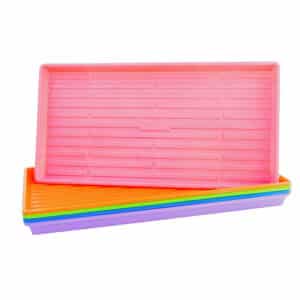
1020 Microgreen Trays – Shallow Extra Strength Colors
Industry leading BootStrap Farmers 1020 microgreen trays! Designed with long lasting durability in mind, these colorful trays are built to withstand years of use and abuse. With a height of 1¼ inches (3.2 cm), these shallow trays make harvests easy, saving you time and increasing your yield. The trays come equipped with 36 drainage holes that effectively remove excess water, promoting a healthy growing environment and preventing mold growth. If you’re serious about growing microgreens and want the best trays available on the market, these trays are it!
